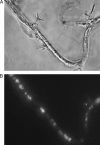D1/D2 domain of large-subunit ribosomal DNA for differentiation of Orpinomyces spp
- PMID: 21784906
- PMCID: PMC3187145
- DOI: 10.1128/AEM.05441-11
D1/D2 domain of large-subunit ribosomal DNA for differentiation of Orpinomyces spp
Abstract
This study presents the suitability of D1/D2 domain of large-subunit (LSU) ribosomal DNA (rDNA) for differentiation of Orpinomyces joyonii and Orpinomyces intercalaris based on PCR-restriction fragment length polymorphism (RFLP). A variation of G/T in O. intercalaris created an additional restriction site for AluI, which was used as an RFLP marker. The results demonstrate adequate heterogeneity in the LSU rDNA for species-level differentiation.
Figures






Similar articles
-
Differentiation of anaerobic polycentric fungi by rDNA PCR-RFLP.Folia Microbiol (Praha). 2006;51(4):273-7. doi: 10.1007/BF02931811. Folia Microbiol (Praha). 2006. PMID: 17007423
-
Differentiation of Candida glabrata, C. nivariensis and C. bracarensis based on fragment length polymorphism of ITS1 and ITS2 and restriction fragment length polymorphism of ITS and D1/D2 regions in rDNA.Eur J Clin Microbiol Infect Dis. 2011 Nov;30(11):1409-16. doi: 10.1007/s10096-011-1235-9. Epub 2011 May 24. Eur J Clin Microbiol Infect Dis. 2011. PMID: 21607825
-
Three-locus identification, genotyping, and antifungal susceptibilities of medically important Trichosporon species from China.J Clin Microbiol. 2011 Nov;49(11):3805-11. doi: 10.1128/JCM.00937-11. Epub 2011 Sep 7. J Clin Microbiol. 2011. PMID: 21900517 Free PMC article.
-
Identification of a new species, Candida subhashii, as a cause of peritonitis.Med Mycol. 2009 May;47(3):305-11. doi: 10.1080/13693780802380545. Epub 2008 Sep 16. Med Mycol. 2009. PMID: 18798116
-
Fundamentals of fungal molecular population genetic analyses.Curr Issues Mol Biol. 2006 Jul;8(2):75-89. Curr Issues Mol Biol. 2006. PMID: 16875415 Review.
Cited by
-
Early-diverging fungal phyla: taxonomy, species concept, ecology, distribution, anthropogenic impact, and novel phylogenetic proposals.Fungal Divers. 2021;109(1):59-98. doi: 10.1007/s13225-021-00480-y. Epub 2021 Sep 29. Fungal Divers. 2021. PMID: 34608378 Free PMC article. Review.
-
PCR and Omics Based Techniques to Study the Diversity, Ecology and Biology of Anaerobic Fungi: Insights, Challenges and Opportunities.Front Microbiol. 2017 Sep 25;8:1657. doi: 10.3389/fmicb.2017.01657. eCollection 2017. Front Microbiol. 2017. PMID: 28993761 Free PMC article. Review.
-
Assessment of microbiota present on a Portuguese historical stone convent using high-throughput sequencing approaches.Microbiologyopen. 2020 Jun;9(6):1067-1084. doi: 10.1002/mbo3.1030. Epub 2020 Apr 30. Microbiologyopen. 2020. PMID: 32352657 Free PMC article.
-
Associative patterns among anaerobic fungi, methanogenic archaea, and bacterial communities in response to changes in diet and age in the rumen of dairy cows.Front Microbiol. 2015 Jul 31;6:781. doi: 10.3389/fmicb.2015.00781. eCollection 2015. Front Microbiol. 2015. PMID: 26284058 Free PMC article.
-
Assessing the Impact of the Methane Inhibitors 3-Nitrooxypropanol (3-NOP) and Canola Oil on the Rumen Anaerobic Fungi.Animals (Basel). 2025 Apr 27;15(9):1230. doi: 10.3390/ani15091230. Animals (Basel). 2025. PMID: 40362045 Free PMC article.
References
-
- Brookman J. L., Mennim G., Trinci A. P., Theodorou M. K., Tuckwell D. S. 2000. Identification and characterization of anaerobic gut fungi using molecular methodologies based on ribosomal ITS1 and 185 rRNA. Microbiology 146: 393–403 - PubMed
-
- Eckart M., Fliegerová K., Hoffmann K., Voigt K. 2010. Molecular identification of anaerobic rumen fungi, p. 297–313 In Gherbawy Y., Voigt K. (ed.), Molecular identification of fungi. Springer, Berlin, Germany
-
- Fliegerova K., Hodrova B., Voigt K. 2004. Classical and molecular approaches as a powerful tool for the characterization of rumen polycentric fungi. Folia Microbiol. (Praha) 49: 157–164 - PubMed
-
- Fliegerova K., Mrazek J., Voigt K. 2006. Differentiation of anaerobic polycentric fungi by rDNA PCR-RFLP. Folia Microbiol. (Praha) 51: 273–277 - PubMed
Publication types
MeSH terms
Substances
Associated data
- Actions
- Actions
- Actions
- Actions
- Actions
- Actions
- Actions
- Actions
- Actions
- Actions
LinkOut - more resources
Full Text Sources
Molecular Biology Databases
Miscellaneous

